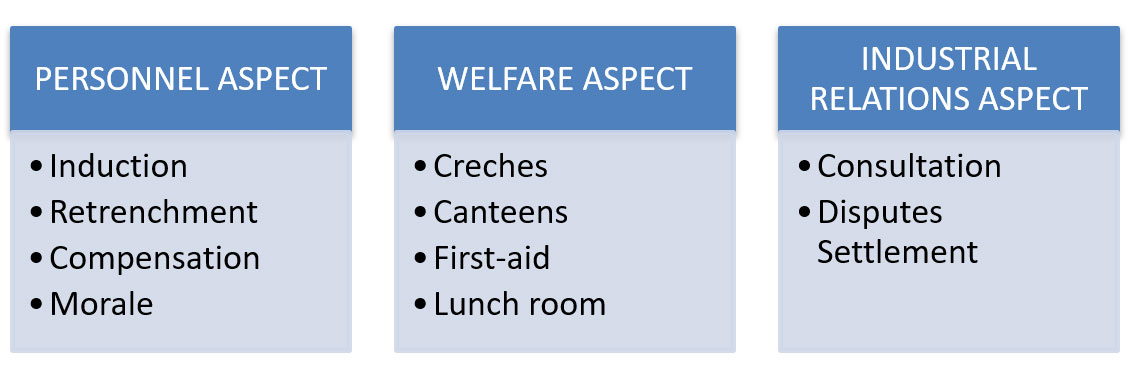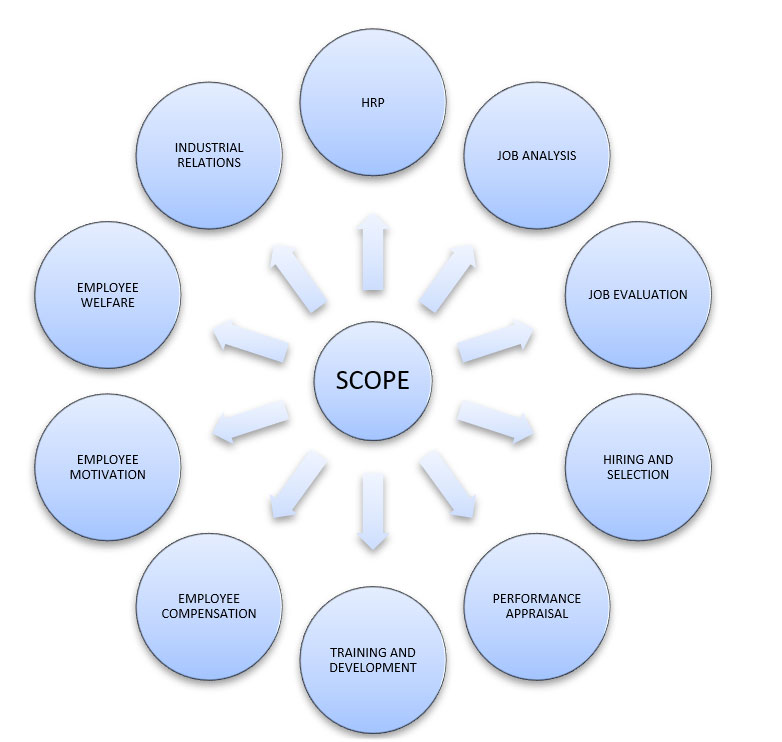10 Scopes of Human Resource Management
Scopes of Human Resource Management: Undoubtedly, the key resources in a business firm are the Human resources which are easiest as well as extremely difficult to handle. At the same token, the responsibility of the HR Department is to design and implement the skills, knowledge and procedures. HRM refers to the dimensions of people within an organization and its proper utilization. All the goals of a business firm can easily be accomplished with the help of manpower, growing their relevant skills and abilities, encourage them to perform in a better way and retain them for a long time.
Also See: Objectives of Human Resource Management
According to Peter Drucker, “Management is multipurpose on which has three jobs, two of which are directly related to personnel- Managing a business, managing managers, and managing workers and the work”.
Different Aspects of Scopes of Human Resource Management
The scope of Human Resource of Management is very wide and it comprises of various innovative things that are still not known. Here are some of the aspects divided into three different categories such as Personnel Aspects, Welfare Aspect and last but not least, Industrial relations aspect. Let’s discuss all these realms in brief below:

1. Personnel Aspect: This aspect is concerned with all the activities and tasks related to the employees of an organization starts from the recruitment process to the motivation among staff. It includes human resource planning, job analysis, job evaluation, hiring, induction, training, lay-off, morale, incentives, productivity, and compensation and so on.
Apart from this, it also comprises of performance appraisal, developing relevant skills and abilities, travelling policies and procedures, allowances, disbursement of wages, and so on.
2. Welfare Aspects: This aspect is associated with the working environment of an organization and to make it better for making improvements in the conditions of working and atmosphere. It deals with various sort of facilities such as canteen, crèches, first-aid, special rooms for lunch, filtered drinking water and others. These are some of the intramural facilities provided to the employees within a business firm. Other extramural facilities include transportation, education, safety, medical assistance and other leisure activities.
Also See: Functions of Human Resource Management
In addition to this, it also relates to the supervision, counselling of employees, education and training to establish proper relationships. It leads to fulfilling the real needs by determining them properly and aims at the active presence of management as well as employees.
3. Industrial Relations Aspect: This type of aspect emphasizes on the relations between the union labour and the management. HRM department helps to maintain the coordination between both the parties be taken into consideration the interest of the organization. It deals with the disputes, conflicts and issues related to the working environment as well as wage rate or pay scale. To exemplify, it involves conciliation, arbitration and adjudication.
Also See: Importance of HRM(Human Resource Management)
The scope of HRM is extremely wide and we have covered all the aspects in three categories above. Now, we are going to discuss all the aspects in detail further.
This article is wholly concerned with the scope of the human resource department which is very vast. It wraps up all the tasks and activities done in the work-life of an employee. Also, you can learn concerning the scope of human resource personnel which is given below:
10 Scopes of Human Resource Management
1. Human Resource Planning (HRP)
This is the first and foremost step. The process of planning in the HR department is related to the evaluation of manpower such as the count of employees, the number of vacant positions and analysis of employees whether there is excess or shortage of staff in any department as well as preparing plans and procedures to cope up accordingly. It also helps to recognize the requirements of manpower for the coming future. Moreover, it signifies a relationship between the supply and availability of employees as per the objective of an organization. So, they can find out the best suitable staff for the organization.
2. Analysis of Job
Job analysis is a vital task of HRM as it provides a base for recruiting, training and developing the staff. They analyze every job in a way that they can avail a suitable candidate for doing the relevant tasks and activities in an efficient manner. Job Analysis provides an in-depth picture of the nature of the job, the required skills, and abilities to perform the job and the duties as well as responsibilities of the employees towards the job.
All this analysis related to the job helps in the process of recruitment and selection of the person who is appropriate for a particular kind of job. In addition to this, they facilitate the new candidates with training and development programs inherent to their job requirement.
3. Job Evaluation
The base of determining the salary and wage is created by the job evaluation. All the tasks and activities done in an organization are evaluated and analyzed in a way that they can get the importance of each job in the accomplishment of the objective of the company. There is ranking, grading and comparison of each job done by the HR department. On the basis of the significance of a particular job in the functioning of an organization, the salary and other benefits are decided for a definite job type. With the help of this process of evaluation, it helps to determine the wage and salary in a fair manner.
Also See: Responsibilities And Role of HR Manager
4. Hiring and Selection
After completing the entire procedure of job analysis and evaluation, the HR department gets to know about the requirement of manpower and explore various platforms from which they can obtain the required manpower, no matter whether the sources are internal or external. This entire process is called hiring and it is also named as recruitment somehow. So, they select an accurate person and put to work.
Various steps are involved in the selection procedure such as receiving applications, interviews, medical examinations, tests and the final selection. The satisfaction of employees is done through the selection and placement process which would be helpful in making improvements such as productivity and also, beneficial for the organization.
Also See: Employee Motivation- Definition, Importance, Techniques, Quotes
5. Performance Appraisal
This is the definite methodologies of managing the employee’s performance. It would be also helpful to evaluate the strength and weaknesses of each employee. This controlling procedure establishes a link between the performance of the employee and the standard level of performance whatever is expected. Moving further, they also take measures in case the actual performance is not up to mark.
It is useful for the management while taking decisions regarding the promotion and pay that will get rewarded if the staff meets the standard or outweigh the standard. To add on, the need for training and development programs for employees is decided by the management and provides enhancements in skills.

6. Training and Development
All the arrangements of training and development programs are handled by the Human Resource Department for the newly joined employee and the current employees also. These programs help to make improvements in qualitative as well as the quantitative performance of the manpower.
Both the external as well as internal situations within the work-life can be managed easily by the employees in the changing technology circumstances. The proper programs related to growth are provided to all the employees that can be helpful to enhance their careers and achieve great heights of success in the near future.
Also See: Performance Appraisal Process: Step By Step Explanation
7. Employee Compensation
HR personnel develop the salary structure and pay scale according to the qualification, experience, skills, efficiency and nature of the job for various employees. In addition to this, they also determine rewards as well as incentives as per the contribution of employees to the organizational goal.
8. Employee Motivation
The retention and sustenance of manpower improve within the organization through proper motivation. Motivation plays a vital role in personnel management and makes improvements in productivity also. Employees get encouragement in various ways and it comprises of reward as well as recognition for performance, hike in pay and other related monetary and monetary benefits.
9. Employee Welfare
An ample number of facilities are provided by the Human Resource department to the employees and encourages them to work in a flexible atmosphere. Some of the facilities that are commonly provided to the employee within the business firm are canteen facilities, medical assistance, creches, rooms for lunch and taking rest, transport, education, health, medical care, housing, sickness advantages and other recreational facilities.
The aim of all these facilities is to provide quality of work-life through positive atmosphere such as security for the job, flexible working hours, reducing the workplace hazards. All these facilities are very optimistic and have a good impact on productivity as well as work quality. Apart from the monetary benefits, all these non-monetary benefits establish a personal relationship with an organization and also improve the morale of the employees.
Also See: Importance of Recruitment and Why It Is Needed?
10. Industrial Relations
The conflicts between the workforce and the management related to the wage or hike in pay, bad working atmosphere, all are the issues that must be managed properly by the Human Resource Management team via maintaining a balance between the organization’s interest and worker’s demands. The department of Human Resource Management is wholly responsible for the maintenance as well as establishing cordial relations between employees and the employer.
The relationship can be maintained through the proper interaction with the labour union and addressing their issues in a proper manner. Moreover, they settle down the disputes via negotiation, bargaining, or consultation in order to retain peace within the business firm.
So, the department of Human Resource Management is not only concerned with the management and motivation of employees within the premises of the organization but also focuses on handling the physical as well as emotional realms of employees. It deals with HR planning, hiring and selection, training and development, job analysis and evaluation, grievance managing, payroll management, rewards and benefits, legal procedures and so on. But in simple words, HRM is all about the maintenance of relationships and establish a balance between organizational objectives and individual objectives.
Also See: Functions of Human Resource Management
So it was all about the different scopes of Human resource management, if you liked it then please share it with your friends.
Leave a Reply